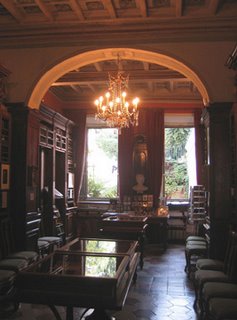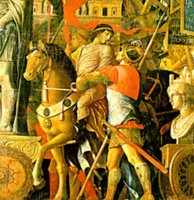Beware the Ides of March! 15 Ways to Caesar the Day!
 In Rome, where past and present happily co-exist, the ancient world is never far away.
In Rome, where past and present happily co-exist, the ancient world is never far away.The month of March, for example, brings visions of Mars, the studly god of war and the mythological "father" of Romulus and Remus, for whom the first month of the Roman year, Martius, was named.
But March also brings thoughts of the all-powerful Julius Caesar who mistakenly paid no heed to the omens that foretold his death. As a result, Caesar was assassinated15th of March in 44 BC as he entered a meeting of the Roman Senate. His death was orchestrated by a conspiracy of Senators who feared his increasing power and thought him a threat to the Roman Republic.
Julius Caesar's assassins claimed he was a tyrant. Yet, since his death some 2051 years ago, innumerable writers and thinkers have debated the motives that compelled him to assume control of the Roman Empire. Was Caesar a noble man or was he an ambitious one? Did he aspire to restore the Republic or did he secretly aspire to be a king? The question remains unresolved and Caesar remains a pivotal figure in the history of the Western world.
On Thursday, March 15, the anniversary of Julius Caesar's death, we invite you to remember the Ides. To this end, we at the iDC offer 15 suggestions as to how you might Caesar the Day!
I. Throw a Toga Party!
What better way to get into the spirit of the Ides than to spend an evening amongst friends, Romans, and countrymen?
Togas might be hard to keep on, but in certain situations that difficulty may prove advantageous. Don't forget to buy enough 'nectar of the gods' and honeyed wine for everyone.
II. Bring Flowers to Caesar's Temple
Bad news! Shakespeare got it wrong! Caesar wasn't killed on the Capitoline Hill (as the play suggests) or in the Forum (as many people believe). Rather, his assassination took place in the Portico of Pompey, near today's Largo Argentina.
Caesar's funeral was a public one. His body was carried to the Forum on an ivory couch and set upon on the Rostra or speaker's platform in a gilded shrine modeled after the Temple of Venus he had recently built in Rome. Mark Antony delivered his famous speech and so moved the crowd that they took over the funeral. Instead of removing Caesar's body out of the Forum for cremation as originally planned, it was burned in this most important public space. Two years later, Caesar was made a god and an altar and temple were erected on the site where his body had been cremated.
Each year on 15 March, Romans visit the ruins of the Temple of Divine Caesar in the Forum, leaving flowers in Caesar's honor.
III. Read Shakespeare's Julius Caesar
(or re-read it)
"Not that I lov'd Caesar less, but that I lov'd Rome more"
So says Brutus when he explains his decision to join the conspiracy against Caesar.
IV. Hip Hop With Marc Antony
Find the Bard a little old fashioned?
His Royal Hipness, Lord Buckley, recast Marc Antony's Funeral Oration, transforming Shakespeare's "Friends, Romans, countrymen, lend me your ears" into "Hipsters, flipsters and finger-poppin' daddies: knock me your lobes." You won't want to miss Buckley's brilliant adaptation of Antony's famous speech.
Read all of Marc Antony's Funeral Oration by Lord Buckley
V. Get Appointed Dictator
In late February of 44 BC, Caesar was made dictator for life, an appointment that spurred Brutus, Cassius and others to start plotting his death.
Caesar denied his autocracy - even refusing the crown of kingship when it was offered to him three times - but he did take the time to advertise his position by minting a coin that read "Caesar Dictator."
The moral of the story: when appointed dictator, be careful!
VI. Read Caesar's Mail
Thornton Wilder's The Ides of March, first published in 1948, is a brilliant epistolary novel set in Julius Caesar's Rome. Wilder called it "a fantasia on certain events and persons of the last days of the Roman republic." Through vividly imagined letters and documents, Wilder brings to life a dramatic period of world history and one of history's most magnetic, elusive personalities.
In this inventive narrative, the Caesar of history becomes Caesar the human being. Wilder also resurrects the controversial figures surrounding Caesar -- Cleopatra, Catullus, Cicero, and others. All Rome comes crowding through these pages -- the Rome of villas and slums, beautiful women and brawling youths, spies and assassins.
Buy Thornton Wilder's Ides of March
VII. Invite Caesar To Your Living Room
HBO's ROME series lets you watch Julius Caesar in wide-screen high-definition format. The dictator has never looked so good! Season One (now available on DVD) chronicles Caesar's rise to power in Rome.
No spoilers here...we won't tell you what happens to him on March 15, 44 BC. You'll have to watch to find out.
Buy Season One of HBO's ROME on DVD
VIII. Order Caesar Salad!
IX. Watch Marlon Brando Play Marc Antony
In Joseph Mankiewicz's film version of Shakespeare's Julius Caesar (1953), Marlon Brando plays the opportunistic Marc Antony and delivers the famous funeral speech with pure conviction.
James Mason plays the honorable Brutus, while John Gielgud is positively serpentine as the lean, hungry Cassius. Louis Calhern is an intelligent but sinister Caesar.
Buy Mankiewicz's Julius Caesar
X. Come, See, Conquer!
Pay homage to Julius Caesar by adopting his slogan "Veni Vidi Vici" - the phrase he so famously coined in 47 BC.
The phrase was the only message the Caesar sent back to the Roman Senate after his victory over Pharnaces II of Pontus in the Battle of Zela. His terse remark - translated as "I came, I saw, I conquered", - simultaneously proclaimed the totality of his victory and served to remind the senate of Caesar's military prowess.
XI. Cross the Rubicon!
Rubicon is the ancient Latin name for a small river in northern Italy, near Ravenna. For the Romans, the Rubicon was the border between the Italian peninsula and Cisalpine Gaul.
The river is notable as Roman law forbade any general from crossing it with a standing army. When Julius Caesar crossed the Rubicon in 49 BC to make his way to Rome, he broke that law and effectively started the civil war that would catapult him to power.
XII. Turn You Calendar to July
The Roman Senate named the month of July for Julius Caesar. It was their way of honoring him after he reformatted the calendar - which had become a chaotic embarrassment. Bad calculations had caused the months to drift wildly across the seasons. January, for example, began in the autumn.
The Julian calendar came into effect in 45 BC. It was created in consultation with Alexandrian astronomers, and had a regular year of 365 days divided into 12 months, with a leap day added to February every four years. Hence the Julian year was on average 365.25 days long.
XIII. Get a Haircut with Fringe
Tired of the same old look?
Surprise your friends with a fringe! Any reputable hairstylist can help you get the Caesar look. It'll be great for the toga party.
XIV. Ask This Question: "Et tu Brute?"
Do you find yourself siding with Caesar rather than against him? Proclaim your loyalties with iDC designed shirts that feature Caesar 's (supposed) last words, "Et tu Brute." The gory stab wounds will help make the point that you're really a Caesarian!
By the way, Caesar probably never said, "Et tu Brute." But what does that matter?
Buy Et Tu Brute Products at the iDC City Shop
XV. Pay a Visit to Caesar's Palace!
"Let the dice fly high!" is what Caesar exclaimed when he dared to cross the Rubicon in 49 BC (at least according to some scholars). What he meant was "let the big gamble begin." Little did he know that so many enthusiastic dice rollers would join him Las Vegas two millennia later!



















